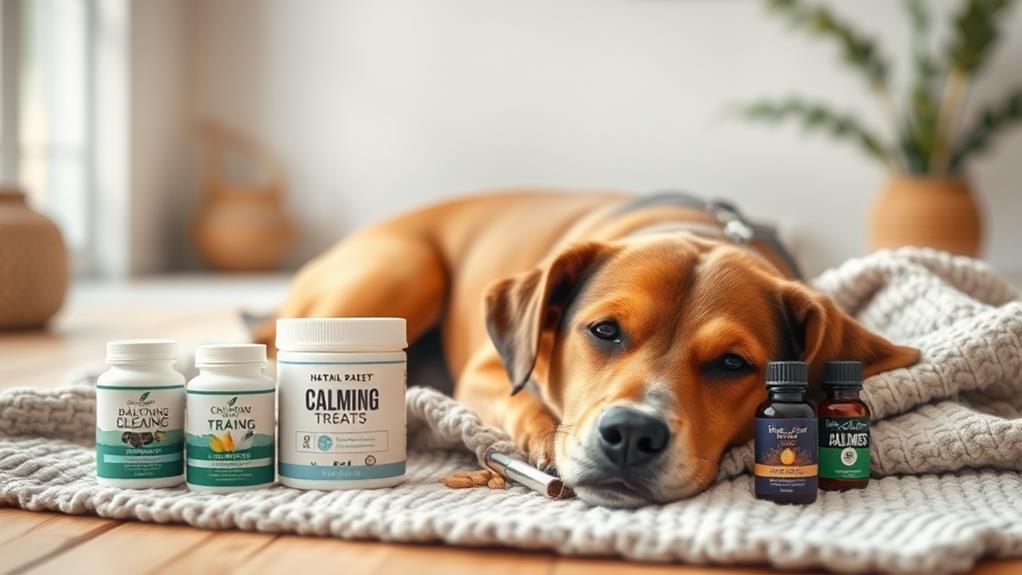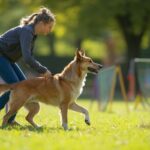To calm an anxious dog, start by creating a safe space in your home. Designate a quiet area with comfy bedding and familiar toys. You can also practice gentle massage, focusing on the neck and shoulders to soothe your pup. Incorporating natural supplements like CBD oil or chamomile can be beneficial, but consult your vet first. Establish a consistent routine and incorporate positive reinforcement training to boost your dog's confidence. Ultimately, modifying the environment with calming music and dim lighting can help immensely. There's so much more to explore that can enhance your dog's well-being.
Understanding Dog Anxiety

Many dog owners mightn't realize that anxiety can affect their pets just like it does humans. Dogs can experience various types of anxiety, including separation anxiety, noise anxiety, and social anxiety. You might notice signs like excessive barking, destructive behavior, or even trembling when your dog feels anxious. Recognizing these symptoms is the first step in helping your furry friend.
Understanding the root cause of your dog's anxiety is vital. It could stem from past trauma, lack of socialization, or even a change in environment. Pay attention to situations that trigger your dog's anxiety; are they scared of thunderstorms or uncomfortable around strangers? Identifying these triggers allows you to address them more effectively.
Additionally, remember that each dog is unique, and what works for one mightn't work for another. Patience and consistency are key. You might also find that your dog benefits from a structured routine, which can provide a sense of security. By understanding your dog's anxiety, you're already taking a significant step towards helping them feel more comfortable and at ease in their surroundings.
Creating a Safe Space

Creating a safe space for your anxious dog can make a world of difference in their comfort level. Start by designating a specific area in your home where your dog can retreat when they feel stressed. This spot should be quiet, cozy, and away from the hustle and bustle of daily life. Use their favorite blanket or bed to create a comfy resting place that smells familiar.
You might want to add a few toys or chew items to keep them occupied and provide positive distractions. Consider using a crate if your dog feels secure in one; just guarantee it's always a safe and positive environment. Keep the space dimly lit and consider playing calming music or white noise to help mask any sudden loud sounds.
It's important to respect your dog's need for solitude when they choose to retreat. Avoid bothering them during this time, allowing them to decompress. Establishing this safe haven can help your dog manage anxiety better and provide them with a sense of security. By creating this supportive environment, you're taking a significant step toward helping your furry friend feel safe and calm.
Calming Massage Techniques

A few simple massage techniques can markedly soothe an anxious dog and strengthen your bond. Start by creating a calm environment. Choose a quiet space where your dog feels comfortable and safe. Begin with gentle strokes along your dog's back, using the palms of your hands to apply light pressure. This establishes a sense of trust.
Next, focus on the neck and shoulders. Use your fingertips to make small circular motions, which can help release tension. Pay attention to your dog's body language; if they lean into your touch, they're likely enjoying the massage. If they pull away, adjust your pressure or try a different area.
You can also try the "ear massage." Gently rub your dog's ears, moving from the base to the tip. This area is sensitive and can be incredibly soothing. Incorporate deep, slow breaths yourself during the massage; your calmness will radiate to your dog.
Lastly, remember that consistency is key. Regular massage sessions not only help reduce anxiety but also build trust and connection between you and your furry friend. So, practice these techniques often to see the best results.
Natural Supplements and Remedies

When it comes to easing your dog's anxiety, natural supplements and remedies can be a game-changer. These options often provide a gentler approach, helping to soothe your furry friend without harsh chemicals. One popular choice is CBD oil, which many pet owners report can reduce anxiety and promote relaxation. Always select high-quality, pet-specific products to guarantee safety.
Another effective supplement is L-Theanine, an amino acid that can help calm your dog during stressful situations. Additionally, valerian root and chamomile are known for their calming properties, making them great natural remedies. You can find these in various forms, including capsules or tinctures.
Don't forget about the benefits of omega-3 fatty acids, which can improve your dog's overall mental health. You might consider incorporating fish oil into their diet or choosing a dog food enriched with these essential nutrients.
Before introducing any new supplement, it's crucial to consult with your veterinarian. They can help you determine the right dosage and ensure that the remedies won't interfere with any existing medications. With the right approach, you can help your dog feel more at ease naturally.
Training and Behavioral Techniques

Effective training and behavioral techniques can make a significant difference in managing your dog's anxiety. Start by establishing a consistent routine. Dogs thrive on predictability, and a structured schedule can help reduce their stress levels.
Incorporate training sessions into your daily activities. Short, positive reinforcement sessions can boost your dog's confidence and create a bond between you two.
Desensitization and counter-conditioning are powerful techniques for addressing specific fears. Gradually expose your dog to anxiety triggers at a low intensity, rewarding them for remaining calm. Over time, increase the exposure while continuing to provide positive reinforcement. This helps your dog associate the trigger with pleasant experiences.
Practicing obedience training can also improve your dog's overall behavior. Command training, like "sit" or "stay," gives your dog a sense of control and certainty. When you notice signs of anxiety, redirect their focus to a command they're comfortable with, reinforcing calm behavior.
Lastly, consider engaging in mental stimulation activities. Puzzle toys or scent work can keep your dog occupied and distract them from their anxiety triggers. With patience, consistency, and love, you'll help your anxious dog feel more secure and relaxed.
Environmental Modifications

Creating a calm environment can considerably alleviate your dog's anxiety. Start by designating a quiet space in your home where your dog can retreat when feeling overwhelmed. This area should be free from loud noises and distractions, providing a cozy, safe haven.
Consider using soothing colors in your dog's space—soft blues and greens can create a tranquil atmosphere. You might also want to reduce clutter, as a tidy space can help minimize stress.
Sound plays an essential role in your dog's comfort. Try using white noise machines or calming music designed specifically for dogs. These sounds can mask sudden noises that might startle your pup.
Scent is another powerful tool. Aromatherapy with dog-safe essential oils, like lavender, can create a relaxing ambiance. Just be sure to consult your vet before introducing any new scents.
Lastly, make certain your dog has access to comfortable bedding and favorite toys in their safe space. This familiarity can help reinforce feelings of security. By making these environmental modifications, you can promote a peaceful atmosphere that greatly reduces your dog's anxiety levels.
Professional Help and Resources

Sometimes, despite your best efforts at environmental modifications, your anxious dog may still need additional support. When you reach this point, seeking professional help can make a significant difference. Certified dog trainers, behaviorists, and veterinarians can provide tailored strategies to help your furry friend.
Here's a quick overview of potential resources you might consider:
| Resource Type | Description | When to Seek Help |
|---|---|---|
| Certified Dog Trainer | Trains dogs using positive methods | If basic training isn't enough |
| Veterinary Behaviorist | Specializes in behavioral issues | If anxiety affects quality of life |
| Veterinarian | Medical professional | If considering medication options |
Frequently Asked Questions
Can Diet Influence My Dog's Anxiety Levels?
Yes, diet can influence your dog's anxiety levels. Certain nutrients, like omega-3 fatty acids and antioxidants, can help promote calmness. Ensuring your dog has a balanced diet might reduce anxiety-related behaviors and improve overall well-being.
How Long Does It Take for Calming Techniques to Work?
When it comes to calming techniques, patience is key. You might see changes within a few days, but lasting effects can take weeks. Stick with it, and you'll likely notice a significant improvement over time.
Are Certain Dog Breeds More Prone to Anxiety?
Yes, certain dog breeds are indeed more prone to anxiety. Breeds like Chihuahuas, Border Collies, and German Shepherds often show higher anxiety levels. Understanding your dog's breed helps you address their specific needs effectively.
Is It Safe to Leave My Dog Alone During Anxiety Episodes?
Leaving your dog alone during anxiety episodes isn't usually wise. You're risking increased stress and potential destructive behaviors. Instead, consider creating a comforting environment or seeking professional help to soothe your furry friend's fears.
What Signs Indicate My Dog Needs Immediate Help for Anxiety?
If your dog shows excessive barking, pacing, trembling, or refusal to eat, it's time to seek immediate help. These signs can indicate extreme anxiety, and addressing them immediately is essential for your dog's well-being.
Conclusion
Ultimately, managing your dog's anxiety requires a mix of patience, love, and the right techniques. While some might think that ignoring the issue will make it go away, the truth is that addressing your dog's needs head-on will lead to a happier, more balanced pet. By implementing calming methods and creating a safe environment, you're not just alleviating their anxiety; you're strengthening the bond between you and your furry friend. Don't wait—start today!



